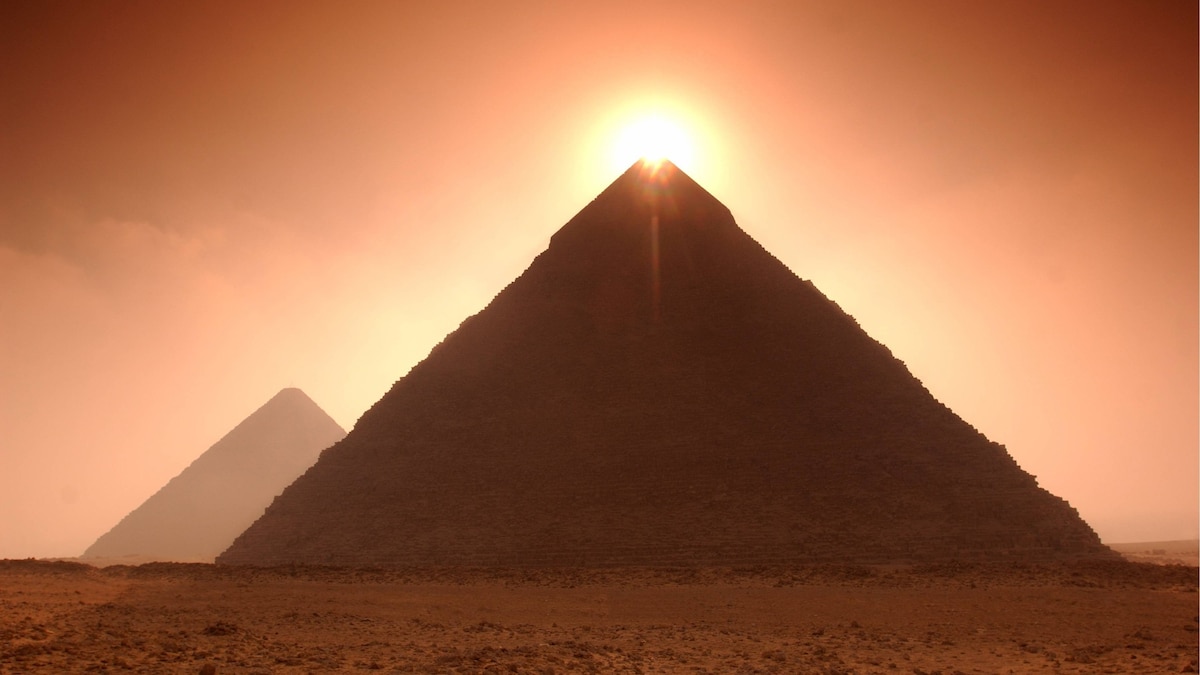Now Reading: Is there really a secret city under Egypt’s pyramids?
-
01
Is there really a secret city under Egypt’s pyramids?
Is there really a secret city under Egypt’s pyramids?

For the past few weeks, the internet has been abuzz with stories about a secret city allegedly located under the Pyramids at Giza. A research team led by retired organic chemist Dr. Corrado Malanga and former academic and remote sensing expert Dr. Filippo Biondi, claim to have discovered and reconstructed enormous 38,000-year-old structures buried deep underneath the pyramid of Khafre at Giza.
In a press conference held in Italy, Malanga and Biondi announced that through the development of a new proprietary method for interpreting Synthetic Aperture Radar (SAR) signals, they were able to detect structures two kilometers beneath the Khafre pyramid. According to Malanga and Biondi, they discovered eight shafts, surrounded by spiral pathways, that connect to two 90-meter cube-shaped structures. Above the shafts, they claim to have found five structures connected to one another by passageways. Using what appears to be AI-generated reconstructions, they, and others, have hypothesized that these structures are part of a legendary ancient city or even a prehistoric power-generating structure (i.e. a power station).
Rumors of hidden structures underneath the Giza plateau are nothing new. The idea dates to the ancient Greek historian Herodotus and intermittently bubbled to the surface of popular consciousness throughout the Middle Ages and Renaissance. They became particularly popular among French scholars in the 19th century and again in the 20th century when American psychic Edgar Cayce popularized the idea that a secret hall of records was buried underneath the pyramid complex. The concept of a power station, allegedly built by aliens, has also been bouncing around pseudoscientific circles for a while. It is part of a broader conspiracy theory that credits impressive ancient architectural projects to aliens.
(How cosmic rays helped find a tunnel in Egypt’s Great Pyramid.)
This newest iteration of the pyramid conspiracy theory has captured public attention because of the scientific credentials of its authors. In the past Malanga and Biondi published a peer-reviewed article on the internal structure of the Khafre pyramid. Though these newer sensational claims have not been peer-reviewed, and one of the authors is well known for publishing books about aliens, the combination of doctorates and an allegedly new technology has captured public attention. The story went viral and was picked up by InfoWars, Joe Rogan, Piers Morgan, and other critics of “mainstream archeology.”
“These claims were received by a public primed for such news from long time claims of mysterious, hidden chambers under the pyramid,” says Dr. Flint Dibble, a well-respected archeologist and science communicator who has headed up 3-D digital mapping projects for a large excavation at Abydos in Egypt and teaches at Cardiff University. “And they appeared legit because of the conflation of peer-reviewed research and the degrees that the scholars hold.”
But as other experts have pointed out, the problem with the lost city hypothesis is that it uses an unproven technology, takes imaginative leaps in its reconstructions, and fails to account for what we know about the archeology of the region.
(Who built the pyramids of Giza?)
You May Also Like
Using technology to explore under the pyramids
To begin with, there are the methods involved in scanning the ground beneath the Giza plateau. As Dibble and public archeologist Milo Rossi have explained, these methods have never been confirmed or proven, nor have they been independently verified. Synthetic aperture radar only detects up to two meters underground in similar conditions. It is difficult to imagine that SAR is providing credible information about structures 2,000 meters beneath the surface.
To be clear, Malanga and Biondi have not discovered a new way of detecting structures two kilometers beneath the ground; instead they claim to have a new method of interpreting these synthetic aperture radar signals. If one compares the images of the radar signals published in the report with the reconstructions they generated, it is clear how much artistic license is being taken in the interpretation of the images. The technology does not allow scientists to create an entire 3-D model or produce the kinds of cross-sections envisioned in the reconstructions. As Dibble joked with Rossi in one podcast, the reconstruction appears to be based on the reactor room of Total Recall.
Alongside public educators like Dibble and Rossi, other established academics have criticized the discovery. Professor Lawrence B. Conyers, an expert in ground-penetrating radar at the University of Denver, told the Daily Mail that the claims of a vast city are “a huge exaggeration.” Egyptian archeologist Dr. Zahi Hawass, the former Ministry of Antiquities, called the claims “baseless” and noted that the Egyptian Council of Antiquities did not grant permits for this kind of study to take place in the Khafre pyramid.
Summing up the interpretative and practical issues, Dr. Sarah Parcak, an award-winning scholar at the University of Alabama who uses cutting-edge satellite imagery to better improve our understanding of Egyptian archeology, said, “I could get any satellite imagery to look almost any way I wanted with enough manipulation… I think that’s what these guys, they’ve done. They’ve misinterpreted the data. And the satellite imagery … SAR data can’t see through rock, period.”
(The pyramids at Giza were built to last an eternity. But how?)
Water, water, everywhere
More problematic, Dibble explained, is the study’s curious avoidance of all the archeological data about Giza plateau that was painstakingly collected over the past two centuries. All these studies, which utilized geochemical analysis, satellite remote sensing, seismic refraction, muon scans, electrical resistivity tomography, ultrasonic testing, ground penetrating radar, and magnetometry, have been carefully checked against one another and in some instances confirmed through excavation and drilling into the bedrock. The cumulative weight of this evidence has led to a robust understanding of what lies beneath the pyramids, how the pyramids were built, and when they were constructed.
The most relevant piece of data here is the water table at Giza. An intensive study performed by Sharafeldin et al in 2019 revealed that the water table at Giza is only a few dozen meters under the surface of the plateau. The proximity of the groundwater, Dibble said, means that even today the Sphinx and other monuments are slowly eroding from water that sometimes “wicks” up from beneath the ground. What this means for this new study is that if there really were megastructures some 2,000 meters underneath the pyramids, they would always have been part of an underwater city. Think Aquaman’s Atlantis, not Amsterdam, Venice, or even the mythical Atlantis that fell into the sea.
(Meet the anti-Indiana Jones solving the pyramids’ secrets.)
In general, water is a critical part of understanding the life course of the pyramids. The pyramids were built soon after the end of the African humid period when greater rainfall meant that the Sahara was more like a verdant savannah. A recent study by Sheisha et al in 2022 showed that during the period of construction the Kufu branch of the Nile extended right up to the Giza plateau, facilitating the transport of the stones needed for the construction of the pyramids. We do not need aliens when we have water.

























